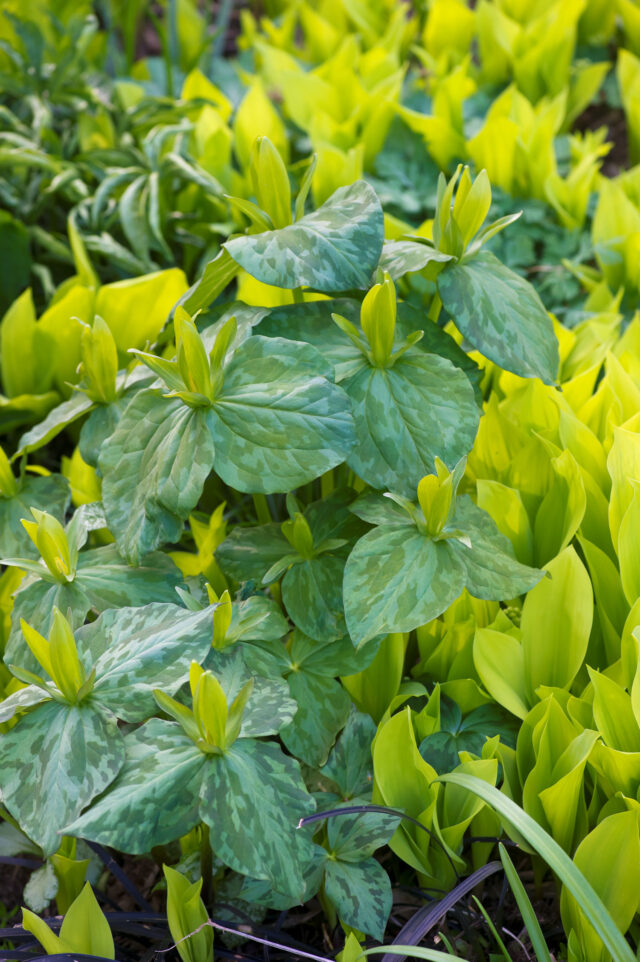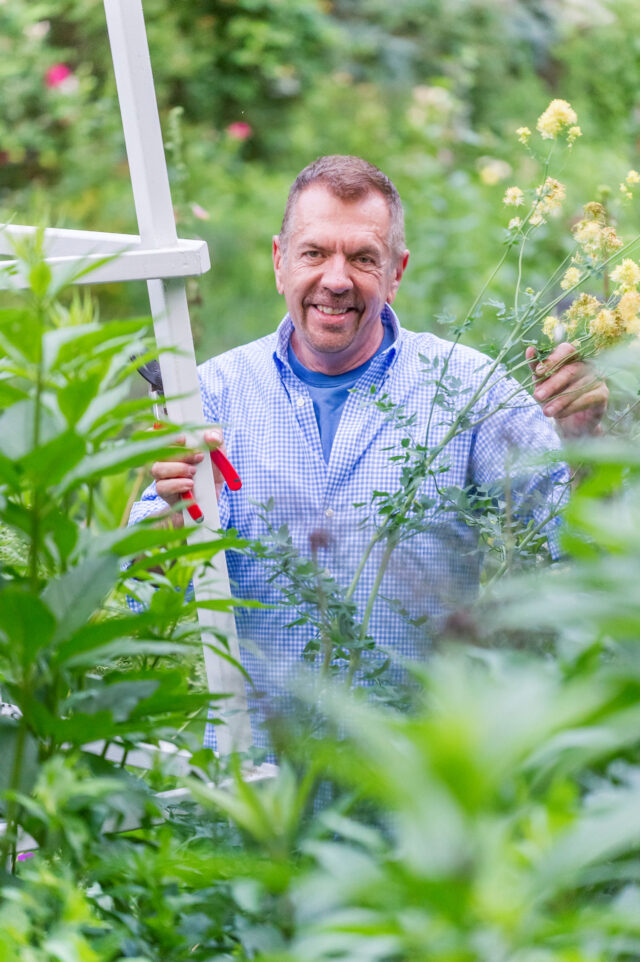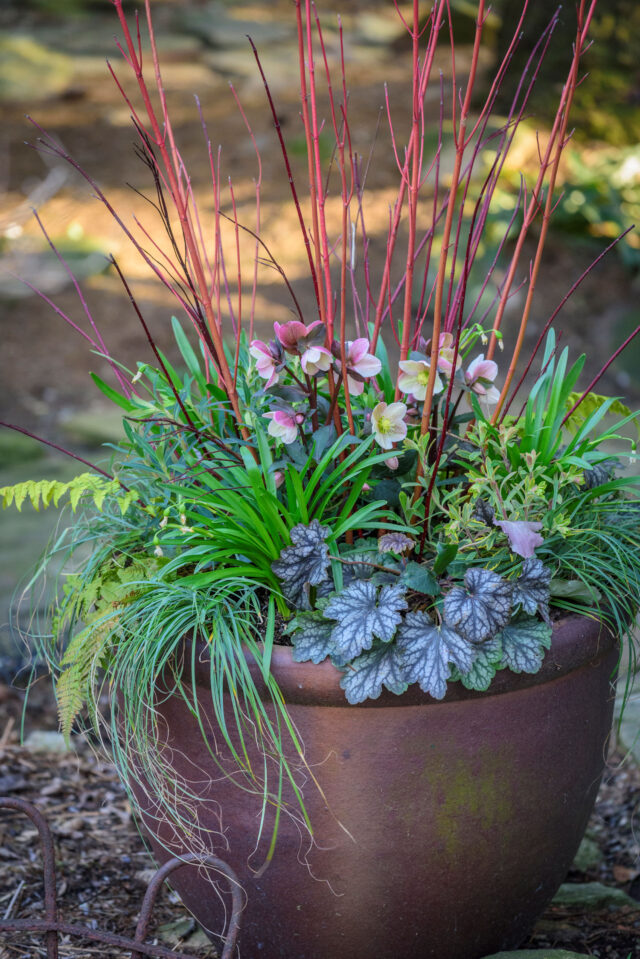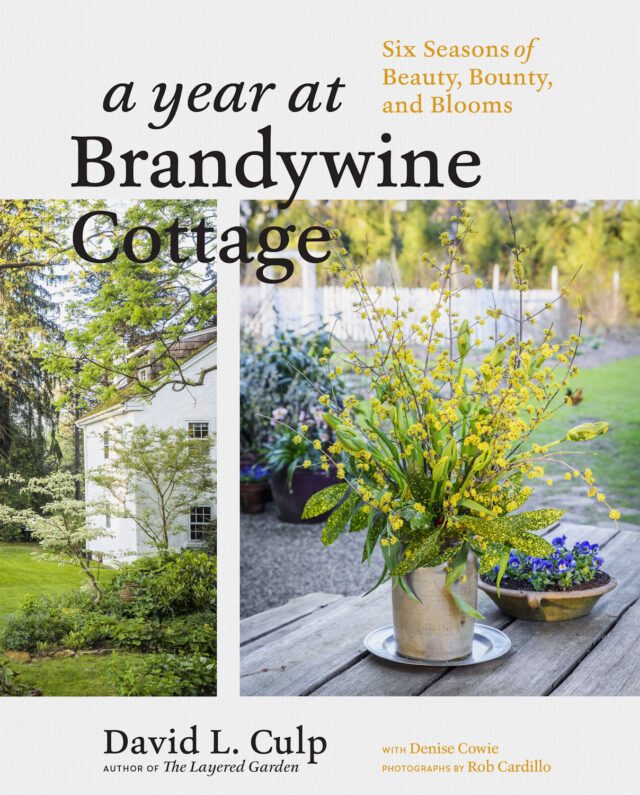It’s the middle of January, and I’m hungry for spring. Spring won’t come for another couple of months in my climate, so I whet my appetite with inspirational gardening books. One of my favorites is The Layered Garden (aff. link) by David Culp. I reviewed that book seven years ago and it’s still one of my all-time favorites. I re-read it at least once a year, and often more frequently, for the gorgeous photographs and the exuberant love of gardening that comes through in the writing.

But I’ve always found the book a little frustrating for the plants left unidentified. Yes, that golden-leaved lily-of-valley on page 38 looks fabulous with the yellow-flowering Trillium luteum, but what is the name of it? And The Layered Garden wasn’t organized chronologically, so it was sometimes tricky to keep track of what happened when.
Enter A Year at Brandywine Cottage: Six Seasons of Beauty, Bounty, and Blooms (aff. link), David Culp’s second book. I think of this as the companion volume to The Layered Garden. Organized chronologically through the seasons, A Year at Brandywine Cottage is part gardening memoir and part lifestyle inspiration–with some recipes thrown in for good measure. The photography by Rob Cardillo is just as lovely as in The Layered Garden, and David’s writing is just as chatty and heartfelt.

In October 2018 I had the opportunity to visit David Culp and his garden at Brandywine Cottage, before the publication of his second book. David talks just the way he writes in both of these books, full of enthusiasm and passion. You never know when a plant will launch him into a little story of how it came into his garden or a certain day when he found it particularly beautiful. This is part of the charm of both books: they read as rambling conversations–just as if you were walking beside him.
A Year At Brandywine Cottage introduces the newest part of his garden, the Meadowette, and an updated map is included on the endpapers. I love garden maps. I firmly believe that every book or article about a specific garden should have a map of that garden. Even better, the vantage point of each photograph should be marked on the map–which is really only feasible in an article. A garden map makes it much easier to understand the layout of the garden and to orient the photographs to one another.

David Culp’s six seasons are Early Spring, Late Spring, Summer, Early Fall, Late Fall, and Winter. He gardens in USDA Zone 6b. In my colder climate, the months are apportioned differently, but the general sequence of bloom is the same. (February is early spring for him, but is most definitely still winter here.) He does get snow, but not persistent snow cover, and has blooms in every month of the year. My snowdrops, witch hazels, and hellebores–his winter bloomers–don’t show up until March. But there is enough overlap of plants hardy to both our gardens that I don’t begrudge him the few he can grow that I can’t.
There is a chapter for each month. In each chapter he describes the signature plants of that month, shows how he uses the garden’s bounty to create floral arrangements and the still-lifes he calls taborets, and shares a few recipes. The recipes reflect his Pennsylvania Dutch heritage or are favorites shared by friends, and feature ingredients he grows in his own garden. Black walnut cookies, ground cherry pie, and sauteed fiddlehead ferns are some of the intriguing offerings.
When I finished reading A Year at Brandywine Cottage, I wished it hadn’t ended. I wanted more–a sure sign of a keeper. If you are engulfed by winter doldrums, you will want to read them both. And I now know the golden-leaved lily-of-the-valley is ‘Fernwood’s Golden Slippers,’ and the hunt is on!
David Culp is currently giving a series of webinars called A Journey Through Your Garden, sponsored by Garden Design. Sign up here to be notified when the next webinar is available for registration.





Thank you for these reviews, I too suffer from garden deprivation in the winter, even if my climate (France, Massif Central) isn’t as cold as yours – we still get plenty of snow! The snowdrops are starting and the witchazels are in bloom, so the seasons in the book sound very similar to mine. I am buying both after reading your post: in a part of my garden, I am trying to create an “American garden” in the old British meaning (https://johnsworldview.wordpress.com/2018/01/01/the-american-garden/) so these books will be a great source of inspiration.
Thank you for commenting, Christine. I had never heard the term American Garden before. David Culp’s garden doesn’t feature azaleas and rhododendrons–I’m trying to remember if he has any–but it does feature flowering shrubs and trees. Not all areas of North America have the acidic soil that rhododendrons need.
I am adapting the American Garden plant list to suit my personal tastes – no rhododendrons but azalea mollis, magnolias and witchazels. Flowers on bare branches are so beautiful. Lucky to have mildly acidic soil that’s also volcanic, so I can grow some acid-haters too.
I’ve added both of those books to my growing request list at the library!
Robin, you will enjoy them!
What a fine review, Kathy. This book hadn’t tempted me — until now. I’m intrigued by your comments about the arrangement of the two books, chronological and ???. What was the organizing principle of the first book… by area? by relationship to the house? by ???
I’ll try to give a brief rundown of the table of contents. Chapter 1: The Layered Garden (concepts, design, maintenance). Chapter 2: The Garden at Brandywine Cottage (describes various areas and how they are layered). Chapter 3: Signature Plants Through the Seasons (featuring his specialties, and some highlights through the seasons). This chapter is greatly expanded upon in the second book. Epilogue: What is Beauty? You will also get a feel for the books by watching the webinars mentioned at the bottom of the post. He says a lot of things and features a lot of photographs that are also in his books. (Big surprise.)